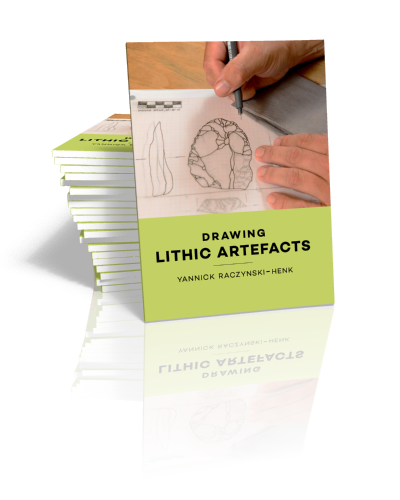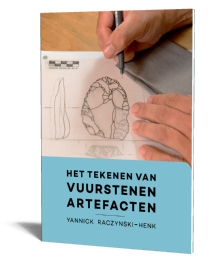Abstract:
Stone Age researchers spend a lot of time studying and documenting lithic artefacts. Since it is impossible to study all these artefacts physically, they often rely on images. Drawings are often the most informative because the lines and symbols in these drawing contain technological information which tells the audience how the artefact depicted was made. Conversely, making these drawings is an excellent way of learning to recognise and understand this technological information.
In a distant past Yannick aspired a career as an artist and while the art world is probably better off without him, he managed to find a new purpose for his artistic bend in his career as an archaeologist in the form of making lithic illustrations.
Both professional and amateur archaeologists ask him questions about the drawings regularly with “It’s probably very difficult, I’m sure?” the most prominent. Drawing lithic illustrations is bound to rules and conventions anybody can learn. Of course it helps if you have a deft hand at drawing, but this style of drawing is a craft, not an art form. A craft anybody can learn with a little perseverance.
Starting from there, Yannick gives courses in drawing artefacts. While preparing these courses he noticed that almost no books or papers suitable as course material are available, a realisation eventually resulting in this book.
Contents
1 Introduction
1.1 Art or craft
1.2 Why draw in the digital age
1.3 Reading guide
2 Conventions
2.1 Introduction
2.2 Terminology
2.3 Angle of incidence
2.4 Projections
2.5 French or American projection
2.6 Lines
2.7 Ripples
2.8 The ventral surface
2.9 Burins
2.10 Polished artefacts
2.11 Natural phenomena and damage
2.12 Burnt flint
2.13 Other symbols
2.14 Microliths
3 Preperations
3.1 Introduction
3.2 Residue and use-wear analysis
3.3 Digital illustration
3.4 Supply list
3.5 Function of the assorted supplies
3.6 The work station
3.7 The artefact
4 The pencil drawing
4.1 Introduction
4.2 Preparing the graph paper
4.3 The outline
4.4 The dorsal ridges
4.5 The dorsal negatives
4.6 The ventral surface and the bulb of percussion
4.7 The lateral sides
4.8 The cross-section
4.9 The striking platform and additional details
4.10 Refits
4.11 Finishing touches
5 The pen drawing
5.1 Preparations
5.2 The lay-out
5.3 Tracing the illustration
5.4 Finishing touches
6 Scanning and digitally editing your illustrations for publication
6.1 Scanning
6.2 Editing your illustration
6.3 Step one: paint it black
6.4 Step two: Increasing the contrast
6.5 Step three: making the illustration binary
6.6 Cosmetic alterations
7 Conclusion


Drs.
Yannick Raczynski-Henk
Yannick Raczynski-Henk (1972) studied Prehistoric archaeology at Leiden University with a special focus on Middle Palaeolithic open air sites in the loess area of Limburg (Netherlands) and the adjoining areas. Since 2003 he works as a geoarchaeologist in the Netherlands, predominantly in the littoral zone of the Dutch Holocene landscapes.
read more












